Solar eclipse of July 10, 1972
| Solar eclipse of July 10, 1972 | |
|---|---|
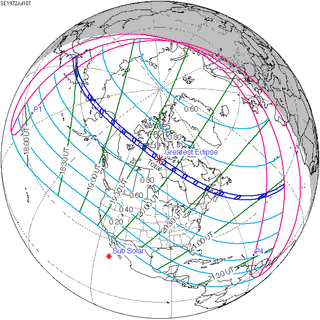 Map | |
| Type of eclipse | |
| Nature | Total |
| Gamma | 0.6872 |
| Magnitude | 1.0379 |
| Maximum eclipse | |
| Duration | 156 sec (2 m 36 s) |
| Coordinates | 63°30′N 94°12′W / 63.5°N 94.2°W |
| Max. width of band | 175 km (109 mi) |
| Times (UTC) | |
| Greatest eclipse | 19:46:38 |
| References | |
| Saros | 126 (45 of 72) |
| Catalog # (SE5000) | 9448 |
A total solar eclipse occurred on July 10, 1972. It was visible as a total eclipse across northeastern Asia and northern Canada, and as a partial eclipse across the United States.
Related eclipses
Solar eclipses of 1971-1974
Each member in a semester series of solar eclipses repeats approximately every 177 days and 4 hours (a semester) at alternating nodes of the Moon's orbit.
Note: Partial solar eclipses on February 25, 1971 and August 20, 1971 occur in the next lunar year set.
| Descending node | Ascending node | |||
|---|---|---|---|---|
| Saros | Map | Saros | Map | |
| 116 |  July 22, 1971 Partial |
121 |  January 16, 1972 Annular | |
| 126 |  July 10, 1972 Total |
131 | 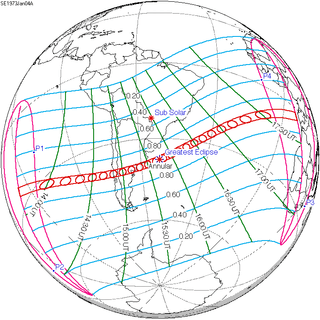 January 4, 1973 Annular | |
| 136 | 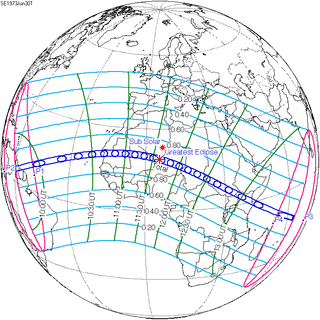 June 30, 1973 Total |
141 |  December 24, 1973 Annular | |
| 146 |  June 20, 1974 Total |
151 |  December 13, 1974 Partial | |
Saros 126
It is a part of Saros cycle 126, repeating every 18 years, 11 days, containing 71 events. The series started with partial solar eclipse on March 10, 1179. It contains annular eclipses from June 4, 1323 through April 4, 1810 and hybrid eclipses from April 14, 1828 through May 6, 1864. It contains total eclipses from May 17, 1882 through August 23, 2044. The series ends at member 72 as a partial eclipse on May 3, 2459. The longest duration of central eclipse (annular or total) was 5 minutes, 46 seconds of annularity on November 22, 1593. The longest duration of totality was 2 minutes, 36 seconds on July 10, 1972.[1]
Series members 39-49 occur between 1901 and 2100:
| 39 | 40 | 41 |
|---|---|---|
 June 8, 1918 |
 June 19, 1936 |
 June 30, 1954 |
| 42 | 43 | 44 |
 July 10, 1972 |
 July 22, 1990 |
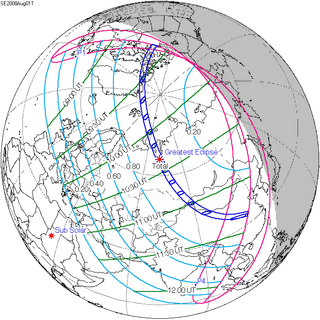 August 1, 2008 |
| 45 | 46 | 47 |
 August 12, 2026 |
 August 23, 2044 |
 September 3, 2062 |
| 48 | 49 | |
 September 13, 2080 |
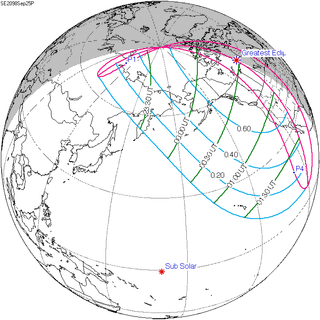 September 25, 2098 |
Metonic series
The metonic series repeats eclipses every 19 years (6939.69 days), lasting about 5 cycles. Eclipses occur in nearly the same calendar date. In addition the octon subseries repeats 1/5 of that or every 3.8 years (1387.94 days).
This series has 21 eclipse events between July 11, 1953 and July 11, 2029.
| July 10-11 | April 29-30 | February 15-16 | December 4 | September 21-23 |
|---|---|---|---|---|
| 116 | 118 | 120 | 122 | 124 |
 July 11, 1953 |
 April 30, 1957 |
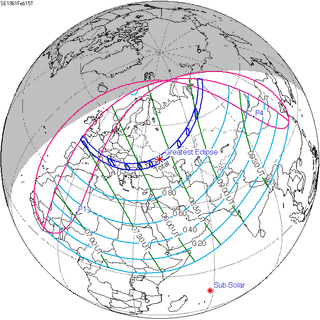 February 15, 1961 |
 December 4, 1964 |
 September 22, 1968 |
| 126 | 128 | 130 | 132 | 134 |
 July 10, 1972 |
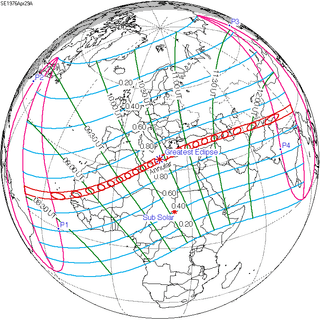 April 29, 1976 |
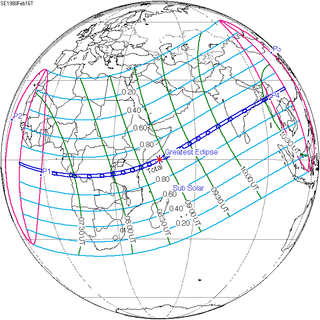 February 16, 1980 |
 December 4, 1983 |
 September 23, 1987 |
| 136 | 138 | 140 | 142 | 144 |
 July 11, 1991 |
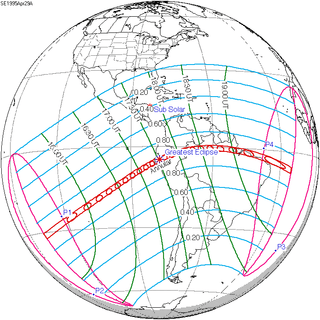 April 29, 1995 |
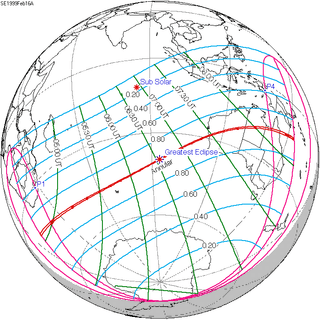 February 16, 1999 |
 December 4, 2002 |
 September 22, 2006 |
| 146 | 148 | 150 | 152 | 154 |
 July 11, 2010 |
 April 29, 2014 |
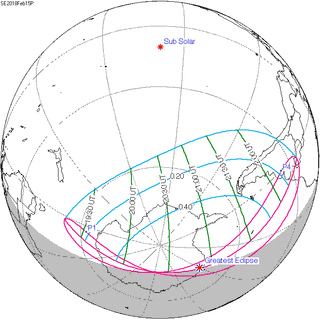 February 15, 2018 |
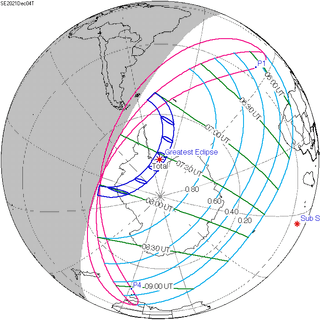 December 4, 2021 |
 September 21, 2025 |
| 156 | ||||
 July 11, 2029 |
In popular culture
Carly Simon's December 1972 pop hit "You're So Vain" contains the lyric "Then you flew your Learjet up to Nova Scotia to see the total eclipse of the sun." As she started writing lyrics that would become this song on a napkin as far back as 1971, the lyrics cannot possibly have been a reference to this eclipse, but only to the one whose path of totality also crossed Nova Scotia two years earlier, on March 7, 1970.
Notes
- ↑ Solar_Saros_series_126, accessed October 2010
References
- Earth visibility chart and eclipse statistics Eclipse Predictions by Fred Espenak, NASA/GSFC
- Foto solar eclipse of July 10, 1972 in Russia
- Foto solar eclipse of July 10, 1972 in Russia (2)
- Image solar eclipse of July 10, 1972
| Wikimedia Commons has media related to Solar eclipse of 1972 July 10. |

